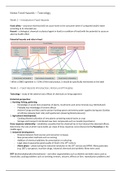Samenvatting
Samenvatting Food Hazards FHM-22806
- Instelling
- Wageningen University (WUR)
Summary Food Hazards (FHM-22806). The summary is quite extensive but contains all information needed to successfully pass the exam. The summary contains figures and (parts of) the lecture slides for better understanding of certain topics and processes.
[Meer zien]









